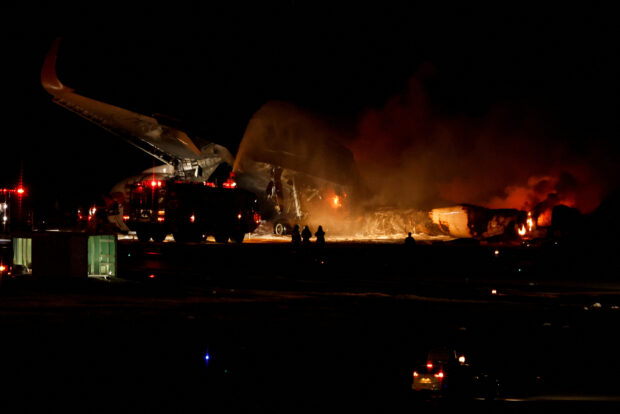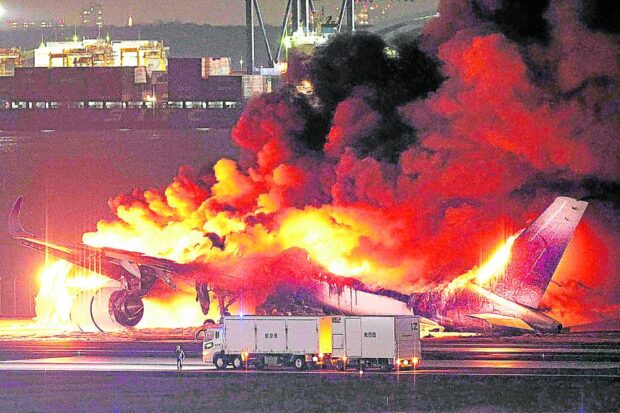Runway safety concerns in focus as Japan probes Tokyo crash

Firefighters work on a burning Japan Airlines’ A350 airplane at Haneda International Airport, in Tokyo, Japan January 2, 2024. REUTERS/Issei Kato
PARIS — Japanese investigators are preparing to probe the collision of two airplanes at Tokyo’s Haneda airport, weeks after the global airline industry heard fresh warnings about runway safety.
All 379 people aboard a Japan Airlines Airbus A350 escaped after a collision with a De Havilland Dash-8 Coast Guard turboprop that killed five of six crew on the smaller aircraft.
People familiar with the investigation said the Japan Safety Transport Board (JTSB) would lead the probe with participation from agencies in France, where the airplane was built, and Britain, where its two Rolls-Royce engines were manufactured.
READ: Five dead in Japan plane collision at Tokyo airport
Experts have cautioned it is too early to pinpoint a cause and stress most accidents are caused by a cocktail of factors.
But investigators are widely expected to explore what instructions controllers gave to the two aircraft, alongside a detailed examination of plane and airport systems.
A ministry official told reporters in Japan on Tuesday that the A350 was attempting to land normally when it collided with the Coast Guard plane, also known as a Bombardier Dash-8.
One of the first tasks will be to recover black box recorders with flight data and cockpit voice recordings.
Experts said the location of the accident means physical evidence, radar data, and witness accounts or camera footage are likely to be readily available, easing the huge forensic task.
“One obvious question is whether the coastguard plane was on the runway and if so why,” said Paul Hayes, director of aviation safety at UK-based consultancy Ascend by Cirium.
READ: IN PHOTOS: JAL plane on fire on runway at Tokyo’s Haneda airport
The crash is the first significant accident involving the Airbus A350, Europe’s premier twin-engined long-haul jet, in service since 2015.
And according to preliminary 2023 data, the collision of the Coast Guard plane with a two-year-old jetliner three times its length follows one of the safest years in aviation.
But it also comes after a U.S.-based safety group warned last month about the risk of runway collisions or “incursions.”
The Flight Safety Foundation called for global action to prevent a new uptick in runway incursions as skies become more congested.
“Despite efforts over the years to prevent incursions, they still happen,” CEO Hassan Shahidi said in a statement.
“The risk of runway incursions is a global concern, and the potential consequences of an incursion are severe.”
Although ground collisions involving injury or damage have become rare, their potential for loss of life is among the highest of any category and near-misses are more common.
A collision between two Boeing 747s in Tenerife in 1977, killing 583 people, remains aviation’s most deadly accident.

DISASTER AT HANEDA A Japan Airlines passenger plane is engulfed in flames on a runway at Tokyo’s Haneda Airport after it collided with a coast guard aircraft on Tuesday night. Japan’s coast guard said its plane was headed to the country’s west coast to deliver aid to those affected by the powerful magnitude 7.6 earthquake that struck on New Year’s Day.—JIJI PRESS/AFP
‘Technology gap’
The Washington-based foundation has found that breakdowns in communication and coordination can play a role in runway crashes or near misses.
But a shortage of electronics to avoid collisions on the ground, rather than in the air where software to trigger avoidance has been available since the 1980s, is also a concern.
“Many of the serious incidents could have been avoided through better situational awareness technologies that can help air traffic controllers and pilots detect potential runway conflicts,” Shahidi said.
The Federal Aviation Administration says some three dozen U.S. airports are fitted with a system called ASDE-X that uses radar, satellites and a navigation tool called multilateration to track ground movements.
But National Transportation Safety Board chair Jennifer Homendy said in November the U.S. aviation network – a bellwether for airports worldwide – lacks sufficient technology to prevent runway incursions.
In 2018, Airbus said it was working with Honeywell on a system called SURF-A or Surface-Alert designed to help prevent runway collisions.
But no date for implementation has yet been announced and rolling out complex new aviation systems can take years.
Far-reaching reforms of European and U.S. air traffic networks that could accelerate the use of such computerized systems have faced chronic delays.
Airbus and Honeywell did not immediately respond to requests for comment.
Steve Creamer, a former senior director at the International Civil Aviation Organization, said preventing a landing aircraft from striking a plane is among the top five global safety priorities.
Although automated landings are increasing, experts say much still depends on visual checks by pilots who may be distracted by a high workload or the blur of a night-time runway.
“I think the investigation will focus a lot on the clearances … and then also what the (JAL) crew could see. Could they physically see that airplane on the runway,” said former U.S. air accident investigator John Cox.
Lighting was an issue in a 1991 collision between a USAir plane and SkyWest Airlines aircraft at Los Angeles International Airport in California, for example.
“One of the things that came out of that was that the USAir crew physically could not see the SkyWest Metroliner there. Although it was on the runway, the lighting was such that you … physically couldn’t see it,” he said.